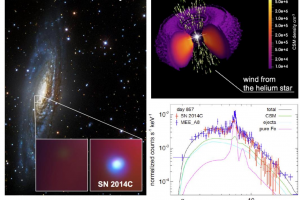Chronology of a Supernova. The article: “Constraining the CSM structure and progenitor mass-loss history of interacting supernovae through 3D hydrodynamic modeling: The case of SN 2014C” by S. Orlando (INAF-OAPA), published in The Astrophysical Journal

The properties and morphology of supernova remnants result from complex physical processes in the progenitor star, both in the stages preceding the explosion and during the event itself. This involves the rapid collapse of the core, occurring in seconds, up to the shock wave reaching the star’s surface. Additionally, the supernova’s evolution is shaped by interactions between the star’s expelled fragments (ejecta) and shock waves, with both interstellar clouds (material surrounding the star) and circumstellar clouds (material ejected by the star before the explosion). These clouds are consistently present because massive stars, especially near the end of their life cycle, exhibit intense stellar winds and impulsive mass-loss events that transfer several solar masses of gas into the surrounding medium.
These intricate interactions can also influence supernovae’s temporal evolution. For instance, as the shock waves impact circumstellar material, an increase in brightness can be observed in specific bands. This occurred, for example, with supernova SN2014C, which exploded in the galaxy NGC7331 at nearly 50 million light-years from us. This supernova was observed and monitored with various telescopes in multiple electromagnetic spectrum bands. Specifically, in X-rays and radio waves, SN2014C exhibited increased brightness about 200 days post-explosion, indicating that the shock wave had collided with dense circumstellar clouds.
The research team, led by astrophysicist S. Orlando (INAF – Astronomical Observatory of Palermo), created a detailed model to replicate the various observations of SN2014C, describing the characteristics of the star, its wind, and the circumstellar material before, during, and after the explosion. The observed properties of the supernova remnant are explained by this model, assuming the progenitor star had ejected its hydrogen-rich outer layers in an intense period of mass loss, beginning about 5000 years before the explosion and ending around 4000 years after. By the end of this phase, the progenitor star had released about 2.5 solar masses of gas, which formed a torus in the star’s equatorial plane, extending from approximately 2900 to 10000 Astronomical Units (1 AU equals roughly 150 million km, or the average distance between Earth and the Sun). The model also accounts for the presence of two distinct temperature components observed in X-rays in the supernova remnant: the hotter component arises from the circumstellar material struck by the shock wave, while the cooler component originates from the stellar fragments expelled during the explosion.
The study is described in the article “Constraining the CSM structure and progenitor mass-loss history of interacting supernovae through 3D hydrodynamic modeling: The case of SN 2014C”, recently published in The Astrophysical Journal. Co-authors include astrophysicists E. Greco and F. Bocchino (INAF – Astronomical Observatory of Palermo) and M. Miceli (University of Palermo).
The cover figure (click here for full view) presents key images from the study. In the left panel: a visible-light image from the Sloan Digital Sky Survey showing galaxy NGC 7331, where supernova SN2014C was observed. The inset images from the Chandra X-ray Observatory show a region of the galaxy before and after the explosion, with colors representing low (red), medium (green), and high-energy (blue) X-rays. Top-right panel: the model showing the density of the circumstellar medium around the supernova. The star marks the location of the supernova, and the arrows indicate the velocity of the stellar wind in the massive star’s final stages. Bottom-right panel: the observed X-ray spectrum from NuSTAR (red symbols) compared with the synthetic spectrum (blue) predicted by the model.
Mario Giuseppe Guarcello
Follow MarioSpiegaCose on Instagram () , Facebook (), Youtube (), and X ()
Follow the Astronomical Observatory of Palermo on Facebok and on Instagram
Subscribe the Youtube channel of the Astronomical Observatory of Palermo
